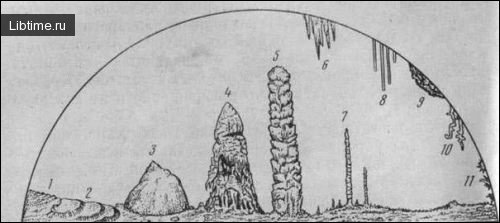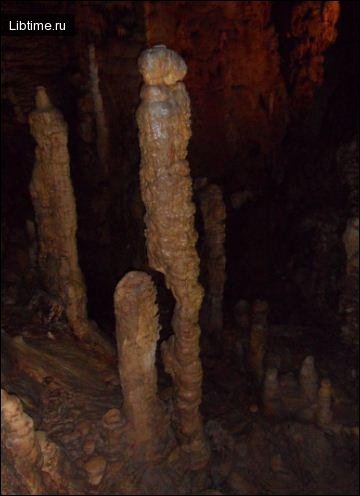The origin of the caves

And the evolution of the so-called double-cycle caves formed by the double uplift of the limestone massif, he distinguished five main stages:
- rudimentary channels, which form in a zone of complete saturation of slow-moving phreatic pressurized waters;
- mature galleries, when mechanical erosion (corrasion) begins to dominate in the conditions of the propagation of unpressurized vadose flows;
- dry galleries resulting from the escape of water deep into the massif due to local uplift of the area;
- natelic-accumulative, characterized by filling of galleries with natelic-drip and other cave sediments;
- destruction of underground galleries.
Stages of cave formation
Based on the development of Davis's views, the idea of phreatic (cave galleries are developed by pressurized groundwater) and vadose (groundwater moves freely, not under pressure, through the galleries toward drainage systems) stages of cave development was created (Bretz, 1942).
You can read about the formation of karst caves in a separate article. The issues of evolution of underground cavities are most fully developed by Soviet researchers G.A. Maksimovich (1963, 1969) and L.I. Maruashvili (1969), who identified several stages of formation of horizontal karst caves.
The first stage is fissure , then crevice. As the width of cracks and crevices increases, more and more water penetrates into them. This activates karst processes especially in areas of pure rock differences.
The cave passes into the channel stage. When the channels expand, underground streams acquire turbulent movement, which favors even more intensification of corrosion and erosion processes.
This is the underground river stage, or vokluzovaya stage. It is characterized by significant filling of the underground channel with water flow and its exit in the form of a vokluzhny source to the day surface, as well as the formation of organ pipes, collapse of vaults, the growth of grottoes.
Due to the erosion of the bottom of the underground channel, water seeps through cracks into the depth of carbonate and halogen strata, where it develops new cavities at a lower level, forming a lower floor of the cave.
Gradually the underground channels widen. The water flow partially and then completely goes into the lower horizons of the massif, and the cave becomes dry. Only infiltration water penetrates into it through cracks in the roof. This is the corridor-grotto nathechno-sedimentary (water-gallery, according to L.I. Maruashvili) stage of cave development.
It is characterized by widespread chemical and mechanical accumulation (in gypsum caves, the stage of natetic accumulation is absent). The ceiling and walls of the cave are covered with various calcite deposits.
Stone and earth shards are formed, the latter are located mainly under the organ pipes. Sediments of rivers and lakes also accumulate. With the departure of the watercourse, the further enlargement of the underground cavity slows down sharply, although corrosive activity continues at the expense of infiltration and condensation waters.
As the cave develops, it passes into the corridor-grotto collapse-cementation (dry-gallery, according to L.I. Maruashvili) stage. At this stage, as a result of roof collapse over underground cavities, some parts of the cave may be opened.
Gradual collapse of the cave vault leads to its complete destruction, which is especially characteristic of the upper parts with a small thickness of the roof. Only karst bridges and narrow arches remain in the surviving parts. At complete destruction of the cave a karst valley is formed.
If the thickness of the roof exceeds 100-200 m, as a rule, no cavities are formed in it, and underground cavities are filled with blocks of rock collapsed from the ceiling and brought sandy-clay sediments, which break the cave into separate isolated cavities.
In this case, the development of the cave ends with the corridor-grotto collapse-cementation stage.
The duration of individual stages of the cave-forming cycle, characterized by their hydrodynamic and morphological features, specificity of physical and chemical processes and peculiarity of bioclimatic conditions, is measured in tens and hundreds of millennia.
Thus, the dry-gallery stage of the Kudaro cave in the Caucasus lasts for 200-300 thousand years.
Tiered caves - caves with floors
Complex cave systems usually consist of areas at different stages of development.
For example, in the Ischeevskaya cave in the Southern Urals, there are sections from the channel stage to the karst valley. 
The distance between two adjacent levels of multistory caves varies from several meters to several dozens. The collapse of the vaults separating the cave floors leads to the formation of giant grottoes, sometimes reaching a height of 50-60 m (Red and Novoafon caves).
G. A. Maksimovich connects the appearance of a new floor with tectonic uplift of the area where the cave is located. N. A. Gvozdetsky attributes the main role in the development of multistory caves in conditions of large thickness of karst rocks to upward movements, which he considers not as a disturbing factor, but as a general background of karst evolution.
According to L.I. Maruashvili, the multistory of caves can be determined not only by tectonic uplift of the karst massif, but also by the general lowering of the ocean level, which causes intensive deepening of river valleys and a rapid decrease in the level of horizontal circulation of karst waters.
In the process of cave formation, sometimes there is a displacement of the axis of cave galleries from the original vertical plane. The displacement of the axis of the cave galleries is due to the inclination of tectonic fractures to which the underground cavities are confined. Interesting article: People and caves.


